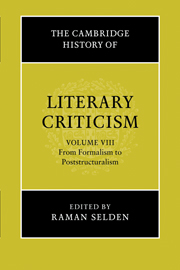Book contents
- Frontmatter
- Introduction
- 1 Russian Formalism
- STRUCTURALISM: ITS RISE, INFLUENCE AND AFTERMATH
- READER-ORIENTED THEORIES OF INTERPRETATION
- 9 Hermeneutics
- 10 Phenomenology
- 11 Reception theory: School of Constance
- 12 Speech act theory and literary studies
- 13 Other reader-oriented theories
- Bibliography
- Index
- References
13 - Other reader-oriented theories
from READER-ORIENTED THEORIES OF INTERPRETATION
Published online by Cambridge University Press: 28 March 2008
- Frontmatter
- Introduction
- 1 Russian Formalism
- STRUCTURALISM: ITS RISE, INFLUENCE AND AFTERMATH
- READER-ORIENTED THEORIES OF INTERPRETATION
- 9 Hermeneutics
- 10 Phenomenology
- 11 Reception theory: School of Constance
- 12 Speech act theory and literary studies
- 13 Other reader-oriented theories
- Bibliography
- Index
- References
Summary
Introduction
It is by now commonplace to point out that unlike such tightly organized schools as structuralism or Marxism, reader-oriented criticism, taking its major forms up until around 1990, is neither united by a common methodology nor directed toward a common goal. As Susan Suleiman notes, it ‘is not one field but many, not a single widely trodden path but a multiplicity of crisscrossing, often divergent tracks’ (‘Varieties of audience-oriented criticism’, p. 6).
Jane Tompkins, it is true, argues, in the introduction to her influential anthology, that there has been a ‘coherent progression’ from formalism to the belief that ‘reading and writing … [are] two names for the same activity’ (‘Introduction’, p. ix). But while this description accurately charts the trajectory of Stanley Fish, reader-oriented criticism as a whole exhibits little historical progression and offers little sense of ultimate arrival. Indeed, there does not even seem to be a common point of origin for the divergent tracks. Even Steven Mailloux's general claim that reader-response critics ‘all share the phenomenological assumption that it is impossible to separate perceiver from perceived, subject from object’ would seem to exclude such important figures as Wayne Booth (Interpretive Conventions, p. 20).
Reader-oriented critics seem at one in their opposition to certain traditional formalist practices – especially, in the United States, to the decontextualization demanded by New Criticism. This hostility to New Criticism, however, is common to most other contemporary theorists as well. Moreover, even if there seems to be a single subject of inquiry ('the reader'), the term, as we shall see, takes on so many different meanings in current discourse that it serves less as a unifying banner than as a trophy to be wrested from the opposition.
- Type
- Chapter
- Information
- The Cambridge History of Literary Criticism , pp. 375 - 403Publisher: Cambridge University PressPrint publication year: 1995
References
- 3
- Cited by

